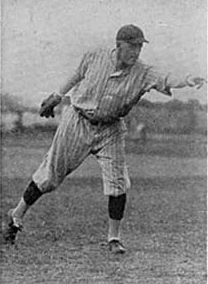Yesterday, May 19, 2011, was the 96th anniversary of a no-hitter by Harry Clayton Harper of Hackensack, New Jersey. From a pitcher’s standpoint, any no-hitter is extraordinary. But history would dictate just how special this gem was. On the surface you have two struggling teams, crosstown rivals whose fans grabbed the local streetcar to head over to the opposition’s city and have a raucous time watching baseball. But it would prove to be a landmark game in the six-decade history of the storied rivalry between the St. Paul Saints and Minneapolis Millers. Here is what I wrote about the event for an upcoming article I’m having published on the 1915 American Association season, slightly edited to provide context:
Sitting at 14-14 just a month into the 1915 season, the St. Paul Saints made the jaunt over to Minneapolis for a matinee against the Millers. And it was then that a funny thing happened on the way back to their season resurrection. On Wednesday, May 19, a rangy, just-turned-20-year-old southpaw named Harry Clayton Harper took the hill for the Millers at Nicollet Park and reeled off a no-hitter. The gem would become the only Millers vs. Saints no-hitter ever in the American Association. The final score: 4-0. The eleventh Minneapolis victory of the season next to 14 losses, it was surely a boost to everyone in the city. Despite Harper’s no-hit heroics, the club did not rebound, losing eight of their next ten. It would be several weeks before Harper and  his Miller teammates could come through with anything resembling a celebration. Could the sparkling event have been foretold? Perhaps the baseball gods were atoning for an earlier lapse on their part. On May 11, Harper struck out 16 Columbus Senators enroute to an extra-inning loss at home, just a sign of the times for Pongo Joe Cantillon‘s men. At least, in Harper, there was something bright about the season after all, and maybe there was something to look forward to in Mudville.
his Miller teammates could come through with anything resembling a celebration. Could the sparkling event have been foretold? Perhaps the baseball gods were atoning for an earlier lapse on their part. On May 11, Harper struck out 16 Columbus Senators enroute to an extra-inning loss at home, just a sign of the times for Pongo Joe Cantillon‘s men. At least, in Harper, there was something bright about the season after all, and maybe there was something to look forward to in Mudville.